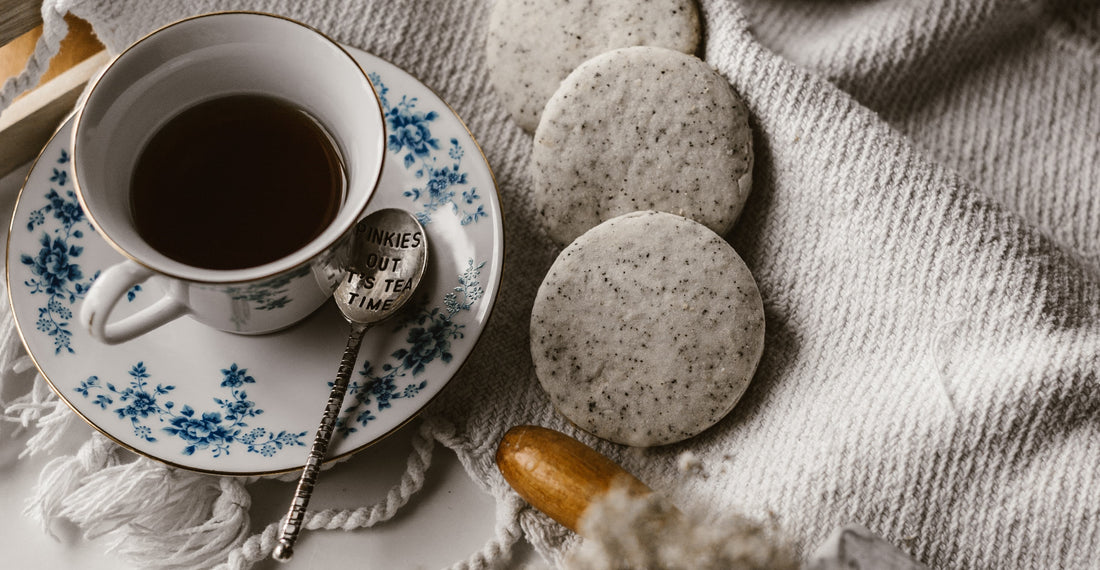
Cooking with Tea: An Adventure!
Michele Lillie
If you are reading this, you probably enjoy a great cup of tea. Did you know, though, that you can also use this very same tea in numerous ways in your kitchen? Let’s take a look at how this is done.
Use the actual tea leaves
Although we do not normally eat our tea leaves, they are edible. The leaves add both flavor and texture to your dish. Most of the time, you will chop or grind the tea before adding it to the other ingredients. In general, 1 tablespoon of loose-leaf tea yields 2 teaspoons of ground tea, or even less if ground to a fine powder. Some recipes call for first steeping the tea and then chopping the wet leaves.
Examples of applications

- Peppermint brownies – grind the sugar from the recipe with dried peppermint tea leaves before continuing with the recipe.
- Chai snickerdoodles – grind masala chai tea and add to your snickerdoodle recipe.
- Toast appetizers – top bread with a spread made with mayonnaise, cheese and finely ground tea leaves.
- Homemade pasta – give your homemade pasta a green color and a subtle flavor by mixing matcha into the dough.
Use the infused liquid
Steep the tea in water or another liquid and use that liquid in your recipe. You probably will want to make your tea a bit more concentrated than you would for drinking purposes. If steeping in water, use more tea leaves rather than increasing the steeping time. The latter can easily lead to bitterness due to the release of tannins from the tea leaves.
If you steep in liquids with a higher fat content (whole milk, cream, butter, oil), you can steep the tea for a longer time as the dairy buffers the tannin development. You can steep up to 90 minutes depending on the taste you wish to achieve.
The concern of tannin development only applies to steeping real tea. Herbal/fruit teas do not get bitter with prolonged steeping. In fact, they require a longer steeping time even for drinking as the flavor infuses a bit more slowly into the liquid.
A couple of tips are that the lower the moisture content and the higher the viscosity of the liquid, the longer the tea will need to infuse.
Another idea for using tea-infused liquid is to cook ingredients in that liquid.
Examples of dishes using tea
- Chicken salad – poach chicken in water to which green tea leaves have been added. The wet leaves are then chopped and stirred into the chicken salad along with the rest of the ingredients.
- Roasted fruit – toss fresh peaches in brewed green tea and then, roast in the oven. Top the roasted peaches with a vinaigrette also made with tea.
- Pizza dough – have your friends ask “What is that special flavor” when you use steeped tea to make your pizza dough.
- Shrimp – marinate shrimp in brewed tea and then make a vinaigrette with more brewed tea.
- Tea rice – cook rice in brewed tea for a special side dish.
- Simple syrups – add tea leaves of your choice to your simple syrup, which can then be used to pour over fresh fruit or added to a cocktail.
- Tarte Tatin – infuse vanilla black tea into the butter and finish as any Tarte Tatin.
- Chocolate truffles – infuse your cream/water with your favorite tea to make a tea-flavored ganache. Make into truffles or use in another application.
- Hot chocolate – infuse tea into the milk and then finish as you would for homemade hot chocolate.
- Pastry cream – infuse tea leaves into dairy to make a delicious pastry cream, which can then be used to make a fruit tart or several other desserts.
- White chocolate mousse – infuse jasmine tea into cream. Use the hot cream to melt white chocolate and make into a wonderful light mousse with a delicate jasmine flavor.
Vinegar
You can easily make tea-infused vinegar by bringing the vinegar to a boil, taking it off the heat and then adding tea leaves to infuse. After cooling to room temperature, strain and use as desired. These infused vinegars are wonderful for making a unique vinaigrette.
Cold steeping
For some liquids that should not be heated such as fruit juices or alcohol, you may steep at room temperature or even in a chilled environment.
Spice Rubs
Add finely ground tea leaves to your favorite spice mixture and add use it as a rub on meat or add to a braising liquid, soup or chutney.
Smoking
Add tea leaves to a stove-top smoker and then smoke the food of your choice. The tea leaves can be the main medium for producing the smoke or used in combination with wood and cooked rice (to buffer the heat). Other flavor components of your choice such as spices may also be added.
There are so many types of teas with a myriad of natural and added flavors. Stop thinking of tea just as a beverage but also as an ingredient. You will be amazed at what you can do with it.